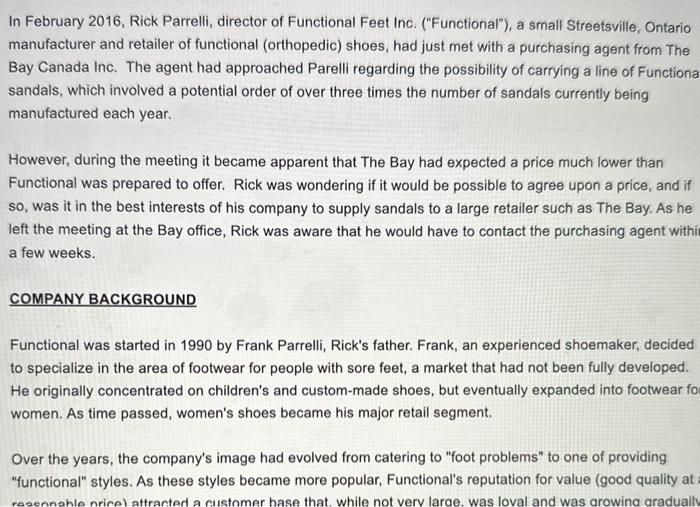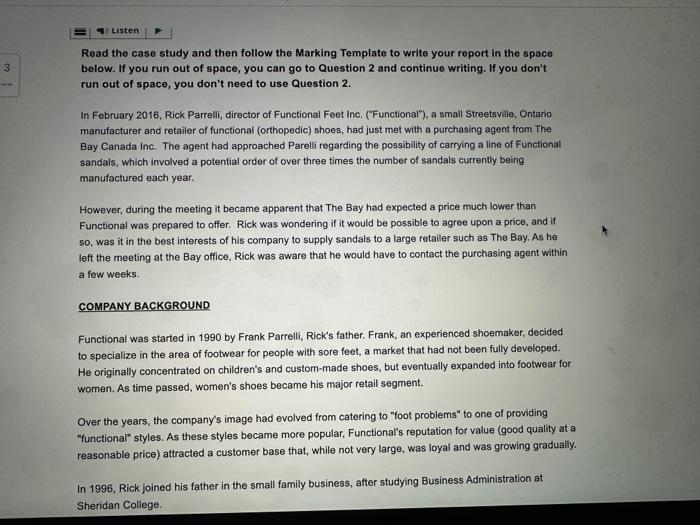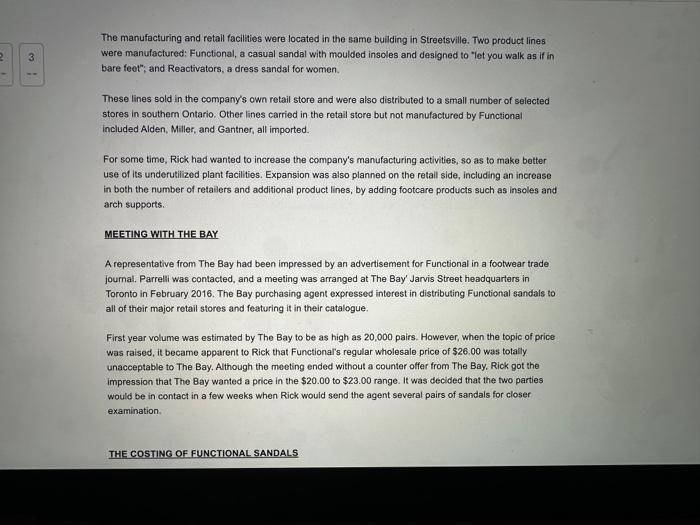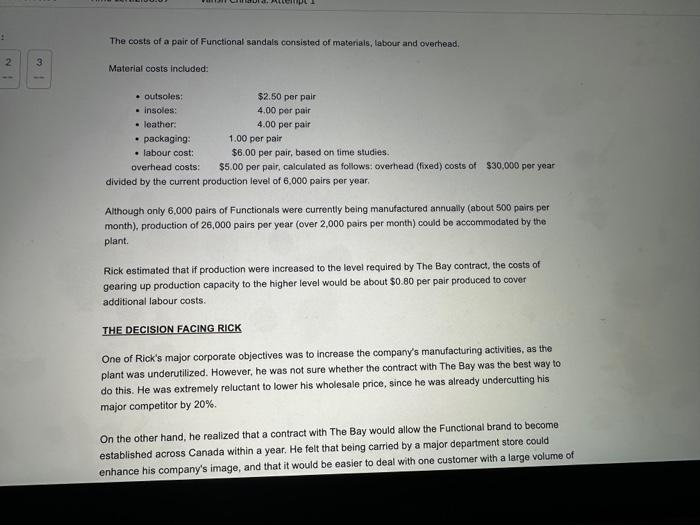please solve the full case study ASAP.


Read the case study and then follow the Marking Template to write your report in the space below. If you run out of space, you can go to Question 2 and continue writing. If you don't run out of space, you don't need to use Question 2. In February 2016, Rick Parrelli, director of Functional Feet Inc. ("Functional"), a small Streetsville, Ontario manufacturer and retailer of functional (orthopedic) shoes, had just met with a purchasing agent from The Bay Canada Inc. The agent had approached Parelli regarding the possibility of carrying a line of Functional sandals, which involved a potential order of over three times the number of sandals currently being manufactured each year. However, during the meeting it became apparent that The Bay had expected a price much lower than Functional was prepared to offer. Rick was wondering if it would be possible to agree upon a price, and if so, was it in the best interests of his company to supply sandals to a large retaller such as The Bay. As he left the meeting at the Bay office, Rick was aware that he would have to contact the purchasing agent within a few weeks. COMPANY BACKGROUND Functional was started in 1990 by Frank Parrelli, Rick's father. Frank, an experienced shoemaker, decided to specialize in the area of footwear for people with sore feet, a market that had not been fully developed. He originally concentrated on children's and custom-made shoes, but eventually expanded into footwear for women. As time passed, women's shoes became his major retail segment. Over the years, the company's image had evolved from catering to "foot problems" to one of providing "functional" styles. As these styles became more popular, Functional's reputation for value (good quality at a reasonable price) attracted a customer base that, while not very large, was loyal and was growing gradually. In 1996, Rick joined his father in the small family business, after studying Business Administration at Sheridan College. The manufacturing and retail facilities were located in the same building in Streetsville. Two product lines were manufactured: Functional, a casual sandal with moulded insoles and designed to "let you walk as if in bare feet"; and Reactivators, a dress sandal for women. These lines sold in the company's own retail store and were also distributed to a small number of selected stores in southem Ontario. Other lines carried in the retail store but not manufactured by Functional included Alden, Miller, and Gantner, all imported. For some time, Rick had wanted to increase the company's manufacturing activities, so as to make better use of its underutiized plant facilities. Expansion was also planned on the retail side, including an increase in both the number of retailers and additional product lines, by adding footcare products such as insoles and arch supports. MEETING WITH THE BAY A representative from The Bay had been impressed by an advertisement for Functional in a footwear trade journal. Parrelli was contacted, and a meeting was arranged at The Bay' Jarvis Street headquarters in Toronto in February 2016. The Bay purchasing agent expressed interest in distributing Functional sandals to all of their major rotail stores and featuring it in their catalogue. First year volume was estimated by The Bay to be as high as 20,000 pairs. However, when the topic of price was raised, it became apparent to Rick that Functional's regular wholesale price of $26.00 was totally unacceptable to The Bay. Although the meeting ended without a counter offer from The Bay. Rick got the impression that The Bay wanted a price in the $20.00 to $23.00 range. It was decided that the two parties would be in contact in a few weeks when Rick would send the agent several pairs of sandals for closer examination. The costs of a pair of Functional sandals consisted of materials, labour and overhead, Material costs included: - outsoles: $2.50 per pair - insoles: 4,00 per pair - leather: 4.00 per pair - packaging: 1.00 per pair - labour cost: $6.00 per pair, based on time studies. overhead costs: $5.00 per pair, calculated as follows: overhead (fixed) costs of $30,000 per year divided by the current production level of 6,000 pairs per year. Although only 6,000 pairs of Functionals were currently being manufactured annually (about 500 pairs per month), production of 26,000 pairs per year (over 2,000 pairs per month) could be accommodated by the plant. Rick estimated that if production were increased to the level required by The Bay contract, the costs of gearing up production capacity to the higher level would be about $0.80 per pair produced to cover additional labour costs. THE DECISION FACING RICK One of Rick's major corporate objectives was to increase the company's manufacturing activities, as the plant was underutilized. However, he was not sure whether the contract with The Bay was the best way to do this. He was extremely reluctant to lower his wholesale price, since he was already undercutting his major competitor by 20% On the other hand, he realized that a contract with The Bay would allow the Functional brand to become established across Canada within a year. He felt that being carried by a major department store could On the other hand, he realized that a contract with The Bay would allow the Functional brand to becomo established across Canada within a year. He felt that being carried by a major department store could enhance his company's image, and that it would be easier to deal with one customer with a large volume of sales. However. Rick was also concerned by the prospect of devoting about 80% of his capacity to one customer, He might also face problems with his suppliers, especially his insoles from Austria, shipments of which tended to arrive late. At the current low level of production, this was not a major problem. However, Rick was unsure how this problem would affect his company at the much higher production levels involved in The Bay contract. He also wondered whether or not a functional shoe was suitable for mass merchandising, and what offect the possibility of a lower retail price by The Bay might have on his own retall business and on his sales and prices through other retailers. In addition, expansion would mean the hiring of additional workers. As he drove back from Toronto to Strestsville, Rick realized that his decision could drastically change the nature of his company. His initial reaction was that he could not afford to lower the wholesale price, but he wanted to expand production and knew that $26.00 would not be an acceptable price to The Bay. Within a few weeks he had to contact The Bay, and wondered what he should do. - end of case - In February 2016, Rick Parrelli, director of Functional Feet Inc. ("Functional"), a small Streetsville, Ontario manufacturer and retailer of functional (orthopedic) shoes, had just met with a purchasing agent from The Bay Canada Inc. The agent had approached Parelli regarding the possibility of carrying a line of Functiona sandals, which involved a potential order of over three times the number of sandals currently being manufactured each year. However, during the meeting it became apparent that The Bay had expected a price much lower than Functional was prepared to offer. Rick was wondering if it would be possible to agree upon a price, and if so, was it in the best interests of his company to supply sandals to a large retailer such as The Bay. As he left the meeting at the Bay office, Rick was aware that he would have to contact the purchasing agent withi a few weeks. COMPANY BACKGROUND Functional was started in 1990 by Frank Parrelli, Rick's father. Frank, an experienced shoemaker, decided to specialize in the area of footwear for people with sore feet, a market that had not been fully developed. He originally concentrated on children's and custom-made shoes, but eventually expanded into footwear fo women. As time passed, women's shoes became his major retail segment. Over the years, the company's image had evolved from catering to "foot problems" to one of providing "functional" styles. As these styles became more popular, Functional's reputation for value (good quality at











